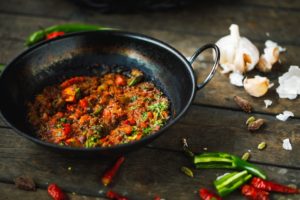Take a tip from Birmingham’s balti czar Andy Munro if you know what’s good for you.
Every Brummie knows that their much -oved local dish was created in Birmingham and that the real thing is fast cooked in vegetable oil over a high flame and served up in the same pressed steel dish (a sort of flat bottomed wok) in which it is cooked.
Now further research commissioned in the Jewellery Quarter through University College Birmingham has revealed unique health and taste properties y comparing a properly prepared balti in one of the Jewellery Quarter-made bowls with a typical pan fried curry

It reveals that traces of health-giving iron in a proper balti are twice the amount of a curry cooked in a frying pan and transferred to a separate serving dish, with iron content in a fast cooked balti cooked and eaten from a pressed steel balti bowl (20.9 mg per kg) compared with one slow cooked and transferred to serving bowl (9.5 mg per kg).
Given that a typical portion of balti is 360mg then the amount of iron in a proper balti is 7.7mg – more than twice that of a normal slow cooked curry
Additionally, the fat content of a balti cooked in vegetable oil (which the high flame helps to burn off) is half that of a typical curry with identical ingredients but slower cooked in ghee. The fat content of a fast cooked balti in oil is 6.5%, compared with 10.8% for one slow cooked in ghee.
Salt content in a fast cooked balti is also lower, at 0.47% compared with 0.59% for a curry one slow cooked in ghee.
Iron is recognised as the most important mineral for the survival of the human race and it is vital in giving energy. As the recommended minimum intake for a man is 8.7 mg (it’s actually 18mg for women of child bearing age) a proper balti is a significant contributor.
Incidentally, it is a myth that a pint of Guinness gives the most significant contribution to iron intake as a pint provides just 0.3mg or less, so you would need to drink about 25 pints to gain the same benefit as a balti. Cheers!


